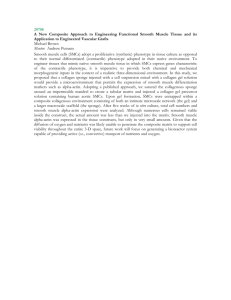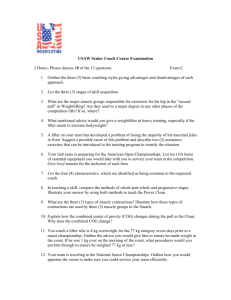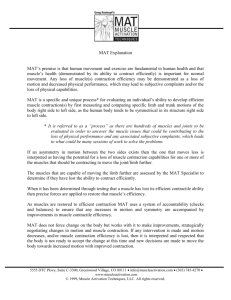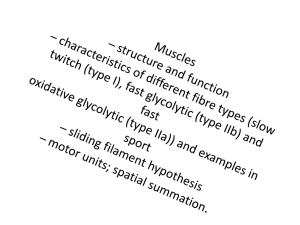The Use of an Isolated Earthworm Crop
advertisement
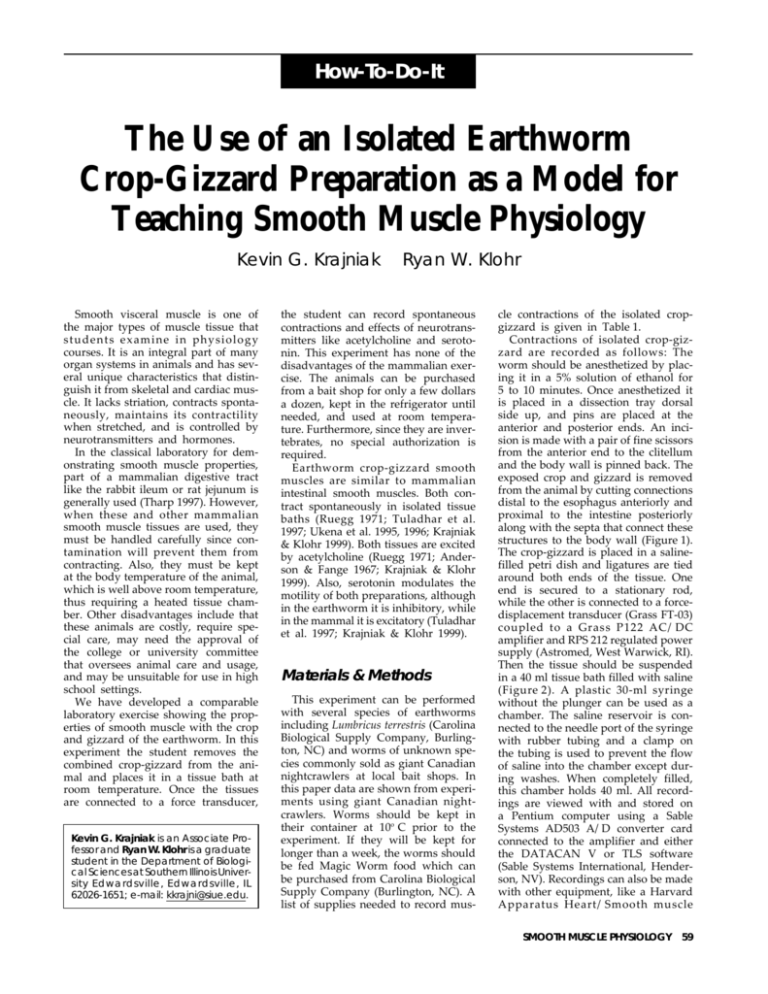
How-To-Do-It The Use of an Isolated Earthworm Crop-Gizzard Preparation as a Model for Teaching Smooth Muscle Physiology Kevin G. Krajniak Smooth visceral muscle is one of the major types of muscle tissue that students examine in physiology courses. It is an integral part of many organ systems in animals and has several unique characteristics that distinguish it from skeletal and cardiac muscle. It lacks striation, contracts spontaneously, maintains its contractility when stretched, and is controlled by neurotransmitters and hormones. In the classical laboratory for demonstrating smooth muscle properties, part of a mammalian digestive tract like the rabbit ileum or rat jejunum is generally used (Tharp 1997). However, when these and other mammalian smooth muscle tissues are used, they must be handled carefully since contamination will prevent them from contracting. Also, they must be kept at the body temperature of the animal, which is well above room temperature, thus requiring a heated tissue chamber. Other disadvantages include that these animals are costly, require special care, may need the approval of the college or university committee that oversees animal care and usage, and may be unsuitable for use in high school settings. We have developed a comparable laboratory exercise showing the properties of smooth muscle with the crop and gizzard of the earthworm. In this experiment the student removes the combined crop-gizzard from the animal and places it in a tissue bath at room temperature. Once the tissues are connected to a force transducer, Kevin G. Krajniak is an Associate Professor and Ryan W. Klohr is a graduate student in the Department of Biological Sciences at Southern Illinois University Edwardsville, Edwardsville, IL 62026-1651; e-mail: kkrajni@siue.edu. Ryan W. Klohr the student can record spontaneous contractions and effects of neurotransmitters like acetylcholine and serotonin. This experiment has none of the disadvantages of the mammalian exercise. The animals can be purchased from a bait shop for only a few dollars a dozen, kept in the refrigerator until needed, and used at room temperature. Furthermore, since they are invertebrates, no special authorization is required. Earthworm crop-gizzard smooth muscles are similar to mammalian intestinal smooth muscles. Both contract spontaneously in isolated tissue baths (Ruegg 1971; Tuladhar et al. 1997; Ukena et al. 1995, 1996; Krajniak & Klohr 1999). Both tissues are excited by acetylcholine (Ruegg 1971; Anderson & Fange 1967; Krajniak & Klohr 1999). Also, serotonin modulates the motility of both preparations, although in the earthworm it is inhibitory, while in the mammal it is excitatory (Tuladhar et al. 1997; Krajniak & Klohr 1999). Materials & Methods This experiment can be performed with several species of earthworms including Lumbricus terrestris (Carolina Biological Supply Company, Burlington, NC) and worms of unknown species commonly sold as giant Canadian nightcrawlers at local bait shops. In this paper data are shown from experiments using giant Canadian nightcrawlers. Worms should be kept in their container at 10o C prior to the experiment. If they will be kept for longer than a week, the worms should be fed Magic Worm food which can be purchased from Carolina Biological Supply Company (Burlington, NC). A list of supplies needed to record mus- cle contractions of the isolated cropgizzard is given in Table 1. Contractions of isolated crop-gizzard are recorded as follows: The worm should be anesthetized by placing it in a 5% solution of ethanol for 5 to 10 minutes. Once anesthetized it is placed in a dissection tray dorsal side up, and pins are placed at the anterior and posterior ends. An incision is made with a pair of fine scissors from the anterior end to the clitellum and the body wall is pinned back. The exposed crop and gizzard is removed from the animal by cutting connections distal to the esophagus anteriorly and proximal to the intestine posteriorly along with the septa that connect these structures to the body wall (Figure 1). The crop-gizzard is placed in a salinefilled petri dish and ligatures are tied around both ends of the tissue. One end is secured to a stationary rod, while the other is connected to a forcedisplacement transducer (Grass FT-03) coupled to a Grass P122 AC/DC amplifier and RPS 212 regulated power supply (Astromed, West Warwick, RI). Then the tissue should be suspended in a 40 ml tissue bath filled with saline (Figure 2). A plastic 30-ml syringe without the plunger can be used as a chamber. The saline reservoir is connected to the needle port of the syringe with rubber tubing and a clamp on the tubing is used to prevent the flow of saline into the chamber except during washes. When completely filled, this chamber holds 40 ml. All recordings are viewed with and stored on a Pentium computer using a Sable Systems AD503 A/D converter card connected to the amplifier and either the DATACAN V or TLS software (Sable Systems International, Henderson, NV). Recordings can also be made with other equipment, like a Harvard Apparatus Heart/Smooth muscle SMOOTH MUSCLE PHYSIOLOGY 59 Table 1. Supplies needed by each group of students Supply Amount Giant Canadian nightcrawler Dissection tray Pins Fine scissors Fine forceps Cotton thread Tissue chamber, a 30 ml syringe body 1 Liter aspirator bottle Rubber tubing to connect the aspirator bottle to the tissue chamber Tubing clamp Ring stand Clamps to hold the tissue chamber and the stationary rod in place Rack and pinion adjustable clamp (Harvard Apparatus, Holliston, MA) to hold the transducer onto the ring stand Stationary rod to hold the crop-gizzard, this can be made from a piece of wire hanger Force transducer Amplifier/power supply Computer 386 processor or better Sable Systems AD503 A/D converter card Sable Systems DATACAN V or TLS software Aquarium air pump connected to 2 feet tubing and syringe needle 1.5ml microcentrifuge tubes 100–1000 ml variable volume pipetteman pH meter Worm saline* Stock solutions of 1012 Molar acetylcholine chloride and serotonin creatinine sulfate (Sigma) solution in distilled water 1 1 10 1 1 1 spool/class 1 1 2 feet 1 1 2 1 1 1 1 1 1 1 1 6 1 1 / class 2 liters 100 ml of each * Composed of 14.26 g NaCl, 0.59 g KCl, 3.02 g NaHCO3, 1.104 g NaH2PO4, 0.444g CaCl2, and 0.406 g MgCl2 in 2 liters of distilled water adjusted to a pH of 7.3 with NaOH and HCl (Vassileva et al. 1982). transducer and a chart recorder. In this instance the crop-gizzard should be connected to one end of the wooden lever that passes through the transducer, and a small counter weight should be added to the other end. A similar setup can be made with a kymograph by connecting the tissue to the stylus that writes on the recording drum. The saline used in the tissue bath and all dilutions of the neurotransmitters are prepared according to the information given in Table 1 and adjusted to pH 7.3 (Vassileva et al. 1982). Artificial seawater diluted to one-third strength may also be used as saline. Serial dilutions of the neurotransmitter with concentrations from 1013 to 1018 M are prepared from a 1012 M stock. A 0.4 ml aliquot of each dilution of neurotransmitter is added to the bath beginning with the lowest concentration. The concentration reported is the final molar concentration in the bath which can be calcu- lated by dividing the concentration of the neurotransmitter added to the bath by 100, since the 0.4 ml of neurotransmitter added is one hundredth of the tissue bath volume of 40 ml. Each dose of neurotransmitter is followed by a saline wash once the maximal effect has been recorded. Air should be bubbled continuously into the tissue bath to ensure a supply of oxygen and mix the neurotransmitters added during the experiment. Serotonin creatinine hydrochloride and acetylcholine chloride can be purchased from Sigma Chemicals (Sigma Aldrich, St. Louis, MO); all inorganic salts can be bought from Fisher Scientific (Houston, TX); artificial sea salts can be purchased from a local pet store. The isolated crop-gizzard shows a complex pattern of contraction and relaxation. In some instances the contractions are regular and the pattern is easily identified, whereas in others the recording may yield a trace in which small sporadic contractions are 60 THE AMERICAN BIOLOGY TEACHER, VOLUME 63, NO. 1, JANUARY 2001 interspersed between large contractions. To analyze these types of traces only the large contractions are used and the small ones are ignored. This analysis results in a dose-response curve similar to one produced by recording from a regularly contracting preparation. All amplitudes should be determined by measuring from the top to the bottom of each wave form. The Sable Systems records the amplitude in volts; however the transducer measures force, so it is necessary to determine a conversion factor from volts to grams of force. This is done by hanging a 0.5-gram weight on the transducer and measuring how many volts are registered on the computer. If either a chart recorder or a kymograph is used the recording will show how many millimeters the tissue has moved. To calibrate these devices the weight must be suspended from the transducer lever or kymograph stylus and the distance moved by the recording instrument should be noted. Contraction rate is determined by counting the time interval between contraction peaks which is minutes per contraction; the inverse of this number is contractions per minute. In each instance, 5 to 10 contractions are measured to establish a mean number. To visualize effects of neurotransmitters it is useful to construct a log dose-response curve. Since the baseline of the contractions may shift during the experiment, we record mean amplitude and contraction rate before and after the addition of each neurotransmitter concentration. Then the percent response for each concentration is calculated using the following formula: % Response 4 post-pre 2 100 pre where post is the post-neurotransmitter value and pre is the pre-neurotransmitter value. The log dose-response curve is created by plotting percent response against log of the neurotransmitter concentration. Log concentration can be calculated by taking the log of the molar concentration, e.g. a concentration of 1015 M would be 15 on the graph since log 1015 is 15. From this curve the threshold concentration for each neurotransmitter can be determined. Another property of smooth muscle the students should observe is the effect of increased tension on the contraction patterns of the smooth muscle. This is accomplished by increasing the distance between the tissue and the transducer. Figure 1. Diagram showing the location of the crop-gizzard in the dissected earthworm. The crop-gizzard is located in the anterior portion of the worm. The ligatures are tied to the region where the crop meets the esophagus and to the gizzard where it comes in contact with the intestine. The septa that attach the crop-gizzard to the body wall must also be severed. Results At room temperature the crop-gizzard contracts spontaneously for several hours (Figures 3 & 4). When there is an increase in tension or stretch, the tissues respond with a compensatory relaxation and then resume the previous rhythmic pattern (Figure 5). Acetylcholine causes a concentration dependent increase in contraction rate and a biphasic change in contraction amplitude (F ig ur e 3 ). Lo g d os eresponse curves of these responses are shown in Figure 6. The increase in contraction rate of the crop-gizzard has a threshold between 1017 and 1016 M (Figure 6a). The increase in contraction amplitude has a threshold between 1018 and 1017 M (Figure 6b). Serotonin causes a concentration dependent decrease in both contraction rate and amplitude (Figure 4). Log dose-response curves are shown for the pooled data in Figure 7. The decrease in contraction rate has a threshold of 10 1 7 and 10 1 6 M (Figure 7a). The decrease in amplitude has a threshold between 1018 and 1017 M (Figure 7b). Discussion The muscle tissue of the earthworm crop-gizzard reacts just like that of mammalian smooth muscle. It responds to increased stretch by relaxation and a return to normal rhythmic contractions. The pharmacological results in giant Canadian nightcrawlers are similar to those found in the earthworms Lumbricus terrestris (Krajniak & Klohr 1999) and Eisenia foetida (Ukena et al. 1995, 1996). Acetylcholine and serotonin modulate the spontaneous contractions as they do in the isolated mam- malian intestine (Ruegg 1971; Tuladhar et al. 1997). Thus the giant Canadian nightcrawler is a good model to demonstrate neurohormonal control of smooth muscle. This laboratory exercise usually takes one three-hour session. The students first assess the effects of stretch on the preparation. Then they perform the experiment with either acetylcholine or serotonin. In the second half of the session the students use the computers to analyze their data and create log dose-response curves. Once the students have generated the numbers for their individual experiments they share them with the other groups to generate pooled data curves. They then plot the log dose-response curves for both their own data and the pooled data. In their laboratory report they are asked to explain the results and compare them to the responses of smooth muscles in other species of annelids and mammals. If the single animal data and pooled data curves are different they are also asked to explain the variation in the data. This laboratory exercise teaches students several different principles of physiology. It demonstrates that digestive tract smooth muscle contractions are spontaneous, continue during an increase in tension, and can be modulated by neurotransmitters like serotonin and acetylcholine. It also familiarizes students with the log doseresponse curve which defines the basic interactions between a drug or neurotransmitter and its receptor. References Anderson, R. & Fange, R. (1967). Pharmacological receptors of an annelid Lumbricus terrestris. Archives Internationales de Physiologie, de Biochimie et de Biophysique, 75, 461–468. Krajniak, K.G. & Klohr, R.W. (1999). The effects of FMRFamide, serotonin, and acetylcholine on the isolated crop-gizzard of the earthworm, Lumbricus terrestris. Comparative Biochemistry and Physiology, 123A, 409–415. Ruegg, J.C. (1971). Smooth muscle tone. Physiological Reviews, 51, 201–248. Tharp, G.D. (1997). Experiments in Physiology, 7th ed. Upper Saddle River, NJ: Prentice Hall. Tuladhar, B.R., Kaisar, M. & Naylor, R.J. (1997). Evidence for a 5-HT3 receptor involvement in the facilitation of peristalsis on mucosal application of 5-HT in the guinea pig isolated ileum. British Journal of Pharmacology, 122, 1174–1178. Ukena, K., Oumi, T., Matsushima, O., Ikeda, T., Fujita, T., Minakata, H. & SMOOTH MUSCLE PHYSIOLOGY 61 Figure 2. A diagram showing the apparatus used to record earthworm crop-gizzard contractions. The illustration shows the crop-gizzard in the tissue bath. One end is tied to a support rod and the other is attached to the force-transducer. The tissue bath is connected to a saline reservoir and an air line. The force-transducer is connected to a power source and an amplifier which is linked to a recording computer. 62 THE AMERICAN BIOLOGY TEACHER, VOLUME 63, NO. 1, JANUARY 2001 Figure 3. The effects of different acetylcholine concentrations on a single isolated crop-gizzard of a giant Canadian nightcrawler. The arrow at the top of the figure and the vertical dashed lines indicate when the neurotransmitter was added; the final molar concentration in the bath is indicated on the left of each record. Figure 4. Effects of increasing serotonin concentrations on a single isolated crop-gizzard of a giant Canadian nightcrawler. The arrow at the top of the figure and the vertical dashed lines indicate when the neurotransmitter was added; the final molar concentration in the bath is indicated on the left of each record. SMOOTH MUSCLE PHYSIOLOGY 63 Figure 5. The effect of stretch on the rhythmic contractions of the isolated crop-gizzard of a giant Canadian nightcrawler. The dashed line indicates when the distance between the crop-gizzard and transducer was increased, resulting in a downward deflection (increase in tension) and a compensatory relaxation (upward deflection). Figure 6. Log dose-response curves showing the effects of acetylcholine on the isolated crop-gizzard of giant Canadian nightcrawlers. (a) Effects of acetylcholine on percent change in contraction rate of the isolated crop-gizzard. (b) Effects of acetylcholine on percent change in contraction amplitude of the isolated crop-gizzard. In both graphs each point is the average of five different preparations and the vertical bars represent standard errors. Figure 7. Log dose-response curves showing the effects of serotonin on the isolated crop-gizzard of giant Canadian nightcrawlers. (a) Effects of serotonin on percent change in contraction rate of the isolated crop-gizzard. (b) Effects of serotonin on percent change in contraction amplitude of the isolated crop-gizzard. In both graphs each point is the average of five different preparations and the vertical bars represent standard errors. 64 THE AMERICAN BIOLOGY TEACHER, VOLUME 63, NO. 1, JANUARY 2001 Nomoto, K. (1995). Effects of annetocin, an oxytocin-related peptide isolated from the earthworm Eisenia foetida, and some putative neurotransmitters on gut motility of the earthworm. Journal of Experimental Zoology, 272, 84–195. Ukena K., Oumi T., Matsushima O., Takahashi T., Muneoka Y., Fujita T., Minakata H. & Nomoto K. (1996). Inhibitory pentapeptides isolated from the gut of the earthworm Eisenia foetida. Comparative Biochemistry and Physiology, 114A, 245–249. Vassileva, P.V., Stoyanov, I.N. & Vassileva, V.I. (1982) On the contractile activity of the alimentary canal of the earthworm (Lumbricus terrestris). Comparative Biochemistry and Physiology, 71C, 127–129. SMOOTH MUSCLE PHYSIOLOGY 65



